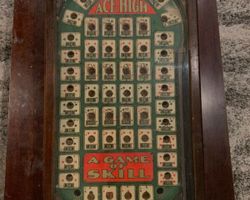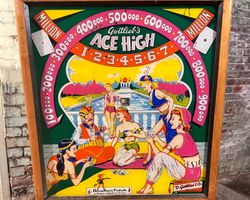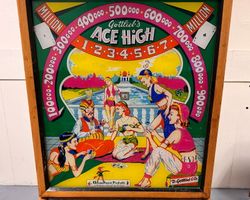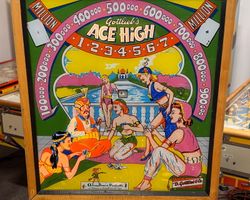Ace High

Average Prices: USD $500 to $2,100
Produced: Febuary, 1957
Production Run: 2,100 units
Machine Type: Electro-mechanical
Players: 1
Design by: Wayne Neyens
Art by: Roy Parker
Gottlieb’s "Ace High" pinball machine, released in February 1957, emerged during a pivotal era for electro-mechanical (EM) games, establishing itself as a significant entry from a prominent manufacturer. D. Gottlieb & Co., a name synonymous with pinball innovation for decades, brought "Ace High" to life with a thematic blend of cards and casino aesthetics. The machine’s visual identity and gameplay mechanics were meticulously crafted to evoke the thrill of a high-stakes card game, a popular and accessible theme for the period.
The development of "Ace High" was primarily spearheaded by Wayne Neyens, who contributed to its design, conceptualization, animation, and mechanical engineering. Neyens was a prolific and influential designer for Gottlieb, known for creating intricate and engaging play experiences. The distinctive artwork that graces both the playfield and the backglass was the creation of Roy Parker, an artist whose work defined much of Gottlieb’s visual appeal during the 1950s. Parker’s artistic touch for "Ace High" integrated playing card motifs with captivating figures, producing an aesthetic that was both vibrant and indicative of its era. This collaborative effort culminated in a production run of 2,100 units, a respectable number for a single-player pinball machine of its time. An interesting historical note is that the Bill of Materials (BOM) for this replay game is dated December 21, 1956, indicating a focused and timely production schedule. "Ace High" also holds a unique position as one of the last single-player Gottlieb games of its kind that did not incorporate a “match feature” or a "Game Over" relay, meaning players could continue to activate the flippers even after all balls had been played, a characteristic that changed in subsequent Gottlieb designs. Its backglass famously displayed Gottlieb's enduring slogan: "Amusement Pinballs, as American as Baseball and Hot Dogs!"
Signature Features and Design
"Ace High" distinguishes itself with a combination of unique mechanical features and striking artistic presentation that define its character and gameplay. The visual allure begins with Roy Parker’s artwork, consistently cited as a major highlight. The backglass and playfield are adorned with an attractive array of playing cards and stylized figures, creating a cohesive and engaging visual package. This detailed artwork is not merely decorative; it integrates with the scoring elements, enhancing the overall experience.
Mechanically, "Ace High" features a unique arrangement centered around three bullseye targets positioned in the mid-playfield. These targets are critical to the machine's progression, and hitting them precisely in the center is rewarded with the illumination of Queens, Kings, and Aces, which are crucial for advancing the game and earning special awards. Complementing these are four pop bumpers, strategically placed to create lively ball action and contribute to faster gameplay for an electro-mechanical machine of its vintage. Two slingshots are situated just below the bullseye targets, adding to the dynamic movement of the ball. The game also incorporates two gobble holes, which serve as high-risk, high-reward features. While they offer the potential for significant scores and replays, their placement can be punishing, as they often capture balls prematurely. This creates a compelling strategic decision for the player: risk a drain for a potentially large reward. The auditory experience is punctuated by three distinct bells and a knocker, providing satisfying feedback for scores and special achievements, reinforcing the classic pinball feel.
Playfield and Mechanics
The playfield layout of "Ace High" is designed to be challenging and rewarding, emphasizing precise flipper control and strategic shot-making. At its core are the three prominent bullseye targets. Achieving a direct hit on these targets is difficult but essential for lighting the Queen, King, and Ace cards, which are tied directly to earning free games. Off-center hits on these targets still award points but do not advance the card progression. Below these central targets, two slingshots add to the chaos and unpredictability of ball movement, often deflecting the ball back towards the upper playfield or into danger zones.
The lower half of the playfield is dominated by the flipper area, flanked by two sets of dual outlanes, which pose a constant threat of ball drains. The design philosophy behind this layout promotes a "shooter's game," where players are continuously challenged to maintain ball control and execute accurate shots. The generous spacing between elements allows for fast, fluid play, but the unforgiving outlanes and strategically placed gobble holes ensure that errant shots are frequently penalized. The artwork throughout the playfield, with its card suit motifs and stylized figures, guides the player's eye and subtly informs the gameplay, integrating the scoring objectives directly into the aesthetic. Lighting elements are used to indicate activated features, such as the illuminated card values and the lit gobble holes, adding visual cues that are vital for strategic play. The two rubber posts nearest the flippers, unlike the slingshots, are passive and do not kick, further emphasizing the need for player skill in guiding the ball.
Gameplay Dynamics
"Ace High" features a sophisticated gameplay progression and scoring system for an EM machine of its era, allowing for scores reaching into the millions. The primary objective revolves around hitting the bullseye targets to light the Queen, King, and Ace cards. Successfully lighting these cards activates the gobble holes for "specials" or replays. The number of replays awarded escalates significantly based on the cards completed: lighting Queens might award one replay, Kings three, and Aces a substantial eight replays, providing a strong incentive for skilled play. This mechanism marked a significant innovation, as "Ace High" was among the first games to award multiple free games for completing a series of required card objectives by hitting bullseye targets.
Beyond the card progression, players can accumulate points by hitting the four pop bumpers and various passive bumpers. Losing a ball into the outlanes is not always a complete loss; it can light the corresponding pop bumpers for a substantial 100,000 points. Similarly, lighting all four card suits in the lower side lanes awards an outhole special and lights the associated pop bumpers for increased scores. These layers of scoring create multiple paths to success, though precision remains paramount. The game’s challenging nature, characterized by frequent ball drains and the strategic dilemma posed by the gobble holes, fosters an addictive "close but no cigar" feeling. Players often find themselves driven to play "just one more game" to perfect their shots, secure the elusive bullseye hits, and capitalize on the high-value gobble hole awards, solidifying its reputation as a true player's machine.
Reception and Legacy
"Ace High" has garnered overwhelmingly positive reception within the pinball community, consistently rated as a highly desirable machine and a standout example from its era. Enthusiasts frequently describe it as a "keeper" and a "gem," particularly appreciated by those who value the strategic depth and skill required in older electro-mechanical games. Its challenging nature is often cited as a strength; there are no easy shots, and ball control is paramount. This demanding gameplay rewards precision and strategic thinking, distinguishing it as a "shooter's game" where mastery is genuinely achievable.
The artwork by Roy Parker is universally praised, described as stunning, beautiful, and an attractive "period piece" that significantly contributes to the machine's appeal. The integration of the scoring system with the artwork, a feature ahead of its time, is also highlighted as unique. While its challenging difficulty, with easy drains and punishing gobble holes, can be a point of contention for some who prefer a more forgiving experience, most view it as an integral part of its addictive charm. The thematic blend of "harem girls" and cards, while visually appealing, is sometimes noted for its somewhat ambiguous connection. Due to its popularity and the intensity of its gameplay, finding well-preserved examples can be difficult, as many machines on location saw extensive play.
The legacy of "Ace High" is significant. It stands as an important milestone for Gottlieb, being one of the initial single-player games to offer multi-free games for specific, objective-based play—a progressive concept for its time. It also represents a transitional period in Gottlieb's single-player machine design, preceding the widespread implementation of Game Over relays that would shut off flipper power. "Ace High" cemented its place in pinball history not just through its production numbers, but through its enduring reputation as a demanding yet deeply rewarding pinball experience that continues to captivate collectors and players alike, solidifying its status as a classic.
Sponsored Links
 Ebay Listings
Ebay Listings
 Auction Results
Auction Results
| Cost | Location | Date |
|---|---|---|
| USD $2,800 |  Massachusetts, United States Massachusetts, United States |
17 April, 2025 |
| USD $1,400 |  Massachusetts, United States Massachusetts, United States |
17 April, 2025 |
| USD $1,000 |  Ohio, United States Ohio, United States |
12 September, 2024 |
| USD $500 |  Iowa, United States Iowa, United States |
02 March, 2020 |
| AUD $750 |  Queensland, Australia Queensland, Australia |
26 August, 2011 |


Private Policy · Search Website · Contact Us
As an eBay Partner, we may earn a commission from qualifying purchases made through links on this site, at no additional cost to you.
All trademarks and copyrighted materials remain property of their respective owners. All other content copyright 2007 - 2025 Pinpedia.




